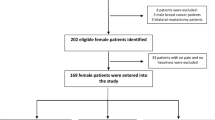Abstract
Background
Despite recent advances in breast-conserving surgery, upper-extremity lymphedema remains a problem for patients after the treatment of breast cancer. This study examines the results of a protocol of therapy for lymphedema in breast cancer patients.
Methods
A total of 135 patients with lymphedema after breast cancer treatment were provided a protocol of complete decongestive therapy (CDT). This involved manual lymphatic drainage, compression garments, skin care, and range-of-motion exercises. Therapy was divided into an induction phase involving twice-weekly therapy for 8 weeks and maintenance therapy individualized to patient needs. Absolute volume and percentage of volume of lymphedema was compared before and after treatment. Also assessed was the degree of chronic pain and the need for pain medication.
Results
Mean initial lymphedema volume was 709 mL, and the percentage of lymphedema was 31%. The induction phase of CDT reduced this to 473 mL and 18%, respectively. Before therapy, 76 patients had chronic pain and 41 required oral pain medication. CDT reduced this to 20 and 11, respectively. The degree of pain was also assessed on a numerical scale from 0 to 10. Those patients with chronic pain initially rated their pain at an average of 6.9. After treatment, this was reduced to 1.1.
Conclusions
Lymphedema continues to be a problem for patients with breast cancer. A program of lymphedema therapy can reduce the volume of edema and reduce pain in this population.




Similar content being viewed by others
REFERENCES
Petrek JA, Heelan MC. Incidence of breast carcinoma-related lymphedema. Cancer 1998; 83(12 Suppl American):2776–81
Kissin MW, Querce della Rovere G, Easton D, Westbury D. Risk of lymphoedema following the treatment of breast cancer. Br J Surg 1986; 73:580–4
Meric F, Buchholz TA, Mirza NQ, et al. Long term complications associated with breast-conservation surgery and radiotherapy. Ann Surg Oncol 2002; 9:543–9
Erickson VW, Pearson ML, Ganz PA, Adams J, Kahn KL. Arm edema in breast cancer patients. J Natl Cancer Inst 2001; 93:96–111
Williams AF, Vadgama A, Fraks PJ, Mortimer PS. A randomized controlled crossover study of manual lymphatic drainage therapy in women with breast cancer–related lymphoedema. Eur J Cancer Care 2002; 11:254–61
Mozes M, Pappa MZ, Karasik A, Reshef A, Adar A. The role of infection in post mastectomy lymphedema. Surg Annu 1982; 14:73–83
McWayne J, Heiney SP. Psychologic and social sequelae of secondary lymphedema: a review. Cancer 2005; 104:457–66
Casley-Smith JR. Benzo-pyrones in the treatment of lymphoedema. Int Angiol 1999; 18:31–41
Rockson SG, Miller LT, Senie R, American Cancer Society Lymphedema Workshop. Workgroup III: diagnosis and management of lymphedema. Cancer 1998; 83(12 Suppl American):2882–5
Casley-Smith JR, Boris M, Weindorf F, Lasinski B. Treatment for lymphedema of the Arm—the Casley-Smith method: a noninvasive method produces continued reduction. Cancer 199815; 83(12 Suppl American):2843–60
Piller NB, Morgan RG, Casley-Smith JR. A double-blind cross-over trial of O-(beta hydroxyl-ethyl)-rotutsides (bezo-pyrones) in the treatment of lymphedema of the arms and legs. Br J Plastic Surg 1998; 41:20–7
Filippetti M, Santoro E, Graziano F, Petric M, Rinaldi G. Modern therapeutic approaches to post-mastectomy brachial lymphedema. Microsurgery 1994; 15:604–10
Gloviczki P. Principles of surgical treatment of chronic lymphoedema. Int Angiol 1999; 18:42–6
Huang GK, Hu RQ, Shen YL, Pan GP. Microlymphaticovenous anastamosis for lymphedema of the external genitalia in females. Surg Gynecol Obstet 1986; 162:429–32
Foldi E. The treatment of lymphedema. Cancer 1998; 83(12 Suppl American):2833–4
Mondry TF, Riffengurgh RH, Johnstone PA. Prospective trial of complete decongestive therapy for upper extremity lymphedema after breast cancer therapy. Cancer J 2004; 10:42–8
Foldi M. On the pathopysiology of arm lymphedema after treatment of breast cancer. Lymphology 1995; 28:151–8
Foldi E, Foldi M, Weissleder H. Conservative treatment of lymphoedema of the limbs. Angiology 1985; 36:71–80
Leduc O, Leduc A, Bourgeois P, Belgrado JP. The treatment of upper limb edema. Cancer 1998; 83(12 Suppl American):2835–9
Andersen L, Hojris I, Erlandsen M, Andersen J. Treatment of breast-cancer–related lymphedema with or without manual lymphatic drainage—a randomized study. Acta Oncol 2000; 39:399–405
Hinrichs CS, Gibbs JF, Driscoll D, et al. The effectiveness of complete decongestive therapy for the treatment of lymphedema following groin dissection for melanoma. J Surg Oncol 2004; 85:187–92
ACKNOWLEDGMENTS
We thank Toni Wakifus, Director of Outpatient Therapy, Health South Rehabilitation Hospital, Memphis, TN; and Allison Hoehn, lymphedema therapist, and Joseph Jardina, Health South Rehabilitation Hospital.
Author information
Authors and Affiliations
Corresponding author
Rights and permissions
About this article
Cite this article
Hamner, J.B., Fleming, M.D. Lymphedema Therapy Reduces the Volume of Edema and Pain in Patients with Breast Cancer. Ann Surg Oncol 14, 1904–1908 (2007). https://doi.org/10.1245/s10434-006-9332-1
Received:
Accepted:
Published:
Issue Date:
DOI: https://doi.org/10.1245/s10434-006-9332-1




